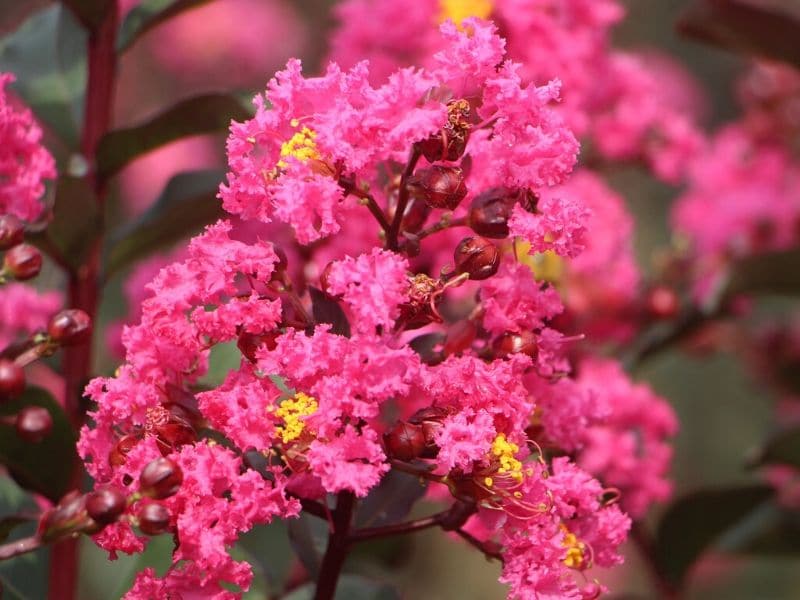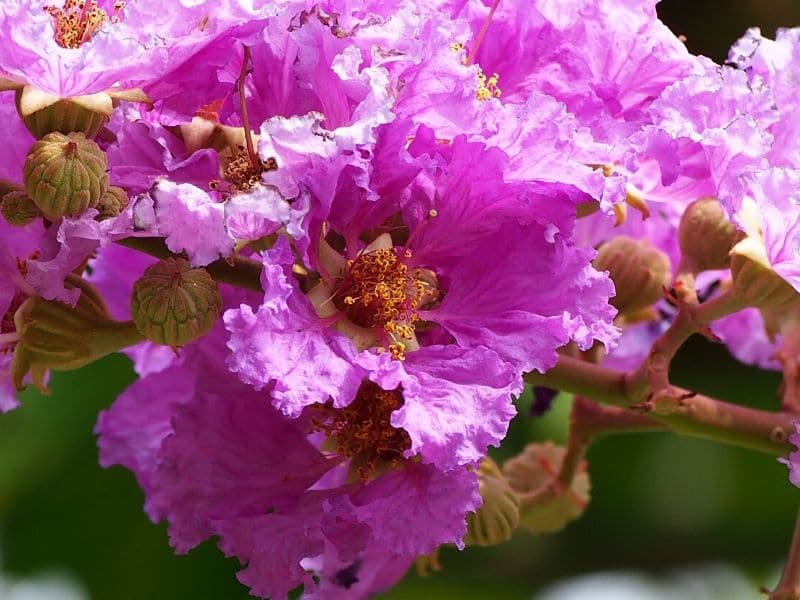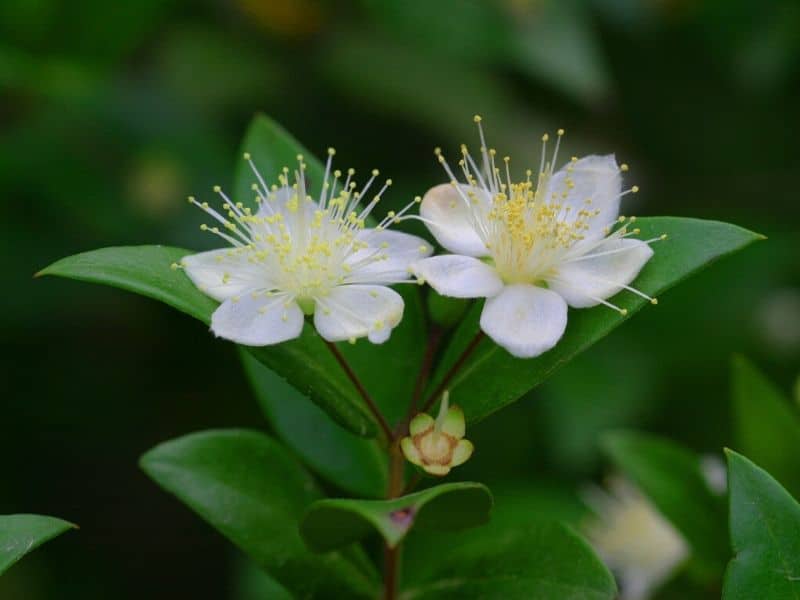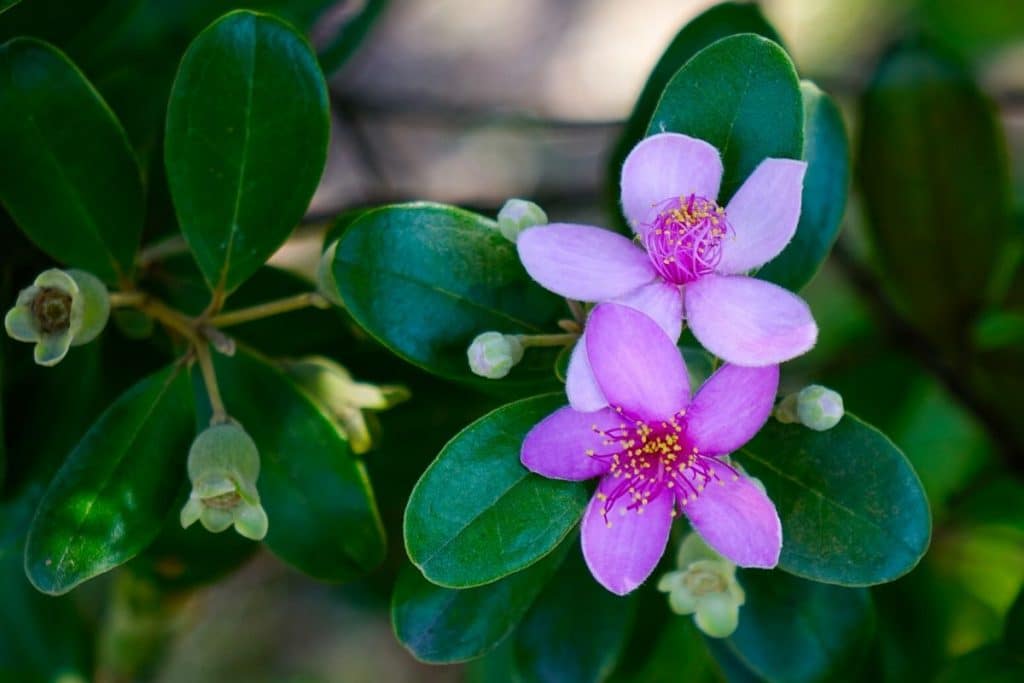Did you know that Myrtle flowers were named after the Greek word ‘’myrrh’’, which means ‘’balm and liquid incense?’’ It is a perfect name, considering an essential oil can be produced with these flowers.
Myrtle plants belong to the family Myrtaceae of flowers and the Myrtus genus. They can be found in the North African continent, Asia, in the Mediterranean, and in South America.
They have an evergreen quality (even though they are also shrubs), so this means that they can grow all year round if their basic needs are met (1).
As previously stated, Myrtus is the genus, but it has three different species, Myrtus Communis, Myrtus Phillyreifolia, and Myrtus Nivellei.
Different cultures think myrtle flowers are essential as they have been used in their rituals, and they now have a substantial role in their traditions. Nowadays, myrtle sprigs are still utilized in royal British wedding bouquets.
What’s more, myrtle flowers have also been used for medical and cosmetic purposes in many cultures around the world, and nowadays, more and more people are waking up to the importance of this particular flower (2).

Myrtle flowers can be white, pink, and purple. They have small flowers and small petals (there are five petals in total), and because this plant can bear fruits that are similar to berries, then they also provide many gastronomical benefits to those who choose to consume them.
Myrtle flowers are significant because you can extract myrtle’s essential oil, which has many health and beauty benefits as well.
Continue reading if you would like to know more about Myrtle flowers. If you’re curious to learn more about other similar plants, check these names of flowers in alphabetical order.
Interesting Facts about Myrtle Plant

Due to its unique qualities, myrtle flowers have been known to several cultures around the world since ancient times. For example, the Romans thought myrtles were linked to love and virginity. Thus, they would always place some in the bridal wreaths.
Myrtle flowers are also very fragrant, a critical condition as it helps to attract possible pollinators, which will, in turn, propagate the seeds of these trees wherever they choose to go.
Would you like to know a fact about myrtle flowers? They can pretty much grow wherever they want! Thus, they can be found anywhere around the globe, as these flowers can be planted in your garden, park, or even inside your house!
They do prefer tropical weather, though, but you could efficiently address this and create your artificial microclimate for your myrtle flowers.
Myrtle Flowers and Ancient Cultures

Aphrodite, the Greek goddess of love, regarded myrtle flowers as something sacred. In fact, did you know that in ancient cultures, the myrtle flower was used as a love potion?
People genuinely believed that this plant was a symbol of immortality; thus, they would give it to their loved ones if they wanted to stay together with them (3).
Moreover, the leaves were prized by the ancient Greeks and Romans for their medicinal and culinary purposes, and the delicate sweetly fragrant white blooms were connected with love and purity.
Popular Types of Myrtle Trees
There are a lot of different types of myrtle trees and shrubs, and most of them share the same characteristics: they either have culinary, medicinal, and/or ornamental values.
Because of these characteristics, myrtle flowers are so popular all over the world, as the whole plant can be used thoroughly for several reasons.
The following are some of the most common types of this myrtle flower plant:
Strawberry Myrtle

It’s called this way because it produces a fruit that’s similar to strawberries. This myrtle is native to Chile, although it can be located in some areas of Argentina as well. It’s usually called ugni molinae or even Chilean Guava as it comes from the same botanical family as the guava tree (and fruit).
It can also be found in Australia, although they are usually called Tazziberry, and in New Zealand, they are called Ugniberry. It’s challenging to find this plant anywhere else in the world.
It can grow up to five feet tall, and it prefers to be placed underneath the direct sunlight. However, if you would like your plant to thrive, you must place them in well-drained soil.
They also have leaves that are perfect for making tea, as they have many medicinal benefits. Its fruits are similar in taste to wild strawberries.
Downy Rose Myrtle
They prefer to be planted in almost sweltering climates; therefore, they also thrive when they are directly exposed to the sun. These trees are native to Asia, and they have pale pink flowers that attract birds and bees alike.
Chilean Myrtle

Not to be confused with the Strawberry Myrtle (or Chilean Guava). They are often called Myrtus apiculata, and it grows in the Central Andes, right between Chile and Argentina.
This evergreen shrub can grow up to 50 feet in height, and it has beautiful and intensely scented white flowers.
The Chilean myrtle’s trunk has an unusual color because it’s sometimes orange and sometimes gray.
Its leaves are oval-shaped, and they tend to flower from midsummer to late autumn (which is from mid-November to mid-June in the southern hemisphere).
Its fruits taste similar to purplish black berries and blueberries and they are valued in their countries of origin.
In fact, these countries produce honey with these plants. And, Mapuche people (who are native to both countries) have high regards of the Chilean myrtle as they are well aware of the many medicinal properties this tree has. It needs to grow in very open areas with lots of sun rays as they cannot be placed nor thrive in shaded areas.
Saharan Myrtle
It can be found in the Central Sahara Desert’s mountains, and they cannot be seen anywhere else in the world. This is why the Tuareg people (who are native to those areas) have consumed this type of myrtle for hundreds of years, and it has become one of their traditional medicinal plants (4).
True Myrtle
It is often referred to as European Myrtle (or Common Myrtle) because, as its name suggests, it is native to Europe, more specifically to the Mediterranean. However, due to the mobilization of people and birds throughout the years, this type of myrtle can also be found in North America, southwestern Europe, and northern Africa.
True myrtle is a shrub that can grow up to six feet tall, and it has pointed leaves that get the attention of lots of animals. In fact, it tends to attract mammals, birds, and insects alike.
They also have small flowers that resemble a star, and they are very fragrant. They tend to bloom during late spring and early summer and aren’t required to be continuously watered, as they are very drought tolerant, climate resistant and deer resistant.
Besides, they don’t require a particular type of soil, but they do need that wherever they are placed is very well-drained as they cannot tolerate being in a very watery environment. Lastly, they produce a fruit that’s very similar to blueberries, but it is not as sweet as them.
Lemon Myrtle

Also known as “Sweet verbena,” this is one of the most fragrant types of myrtle out there. They have yellow and white flowers that attract many animals and bees alike.
It tends to grow in subtropical climates where rainforests are everywhere; thus, this would be places like Southerneastern Queensland in Australia, or some rainforests near the Amazonia in South America.
This tree can grow up to 26 feet in height, and they have very fragrant dark-green leaves. Its showy white flowers also have a distinct color, which is cream.
It can be said that the aroma of these glossy green leaves is similar to lemongrass but somehow more reliable. It is also a plant that has been used by many indigenous communities worldwide, and even though it’s native to Australia, nowadays, it can also be found in Europe and even in the United States.
Many other countries (such as China) have been planting lemon myrtles as they need the essential oil that can be extracted from this tree to produce personal care products such as soaps, lip balms, and even body lotions.
Rose Myrtle
Rose myrtle can be found in India, Malaysia, and southern China. They tend to grow in natural and wet forests. Thus, they prefer humid climates. They can grow up to 12 feet tall and have very dark green leaves.
On the other hand, its flowers are pink, and they usually grow in clusters of two or more flowers, making them eye-catching and unique.
Rose myrtles produce a fruit that can be eaten raw, and it’s very, very sweet. People use it to make homemade jams, pies, and even fruit-based salads.
They are very common in these Asian countries as well because they are aware of the medicinal effects it has (5).
Some people tend to think of them as invasive flowers because they spread out quickly and rapidly.
Willow Myrtle
Also known as the Western Australian peppermint plant, it’s a tiny tree that can grow up to 32 feet in height. It also has white flowers that are very small and bloom throughout spring and late summer. They thrive in sandy soils and are also considered as an invasive species.
Common Myrtle (Myrtus communis)
One of the most popular types of myrtles, common myrtle looks excellent indoors because it’s a dwarf species (in comparison to other myrtles). It has pink and white flowers, and it tends to bloom throughout the summer. Its fruits are red and black berries, which are very sweet.
Ralph Myrtle (Myrtus ralphii)
It’s a small myrtle shrub that has pink flowers and red berries. They thrive in hot climates, and they prefer well-drained soil. This plant requires a long hot summer in order to produce blooms and fruits.
Growing and Caring for Myrtle Flower
Even though growing myrtle flowers can be very satisfying, it’s fair to say that it’s not one of the easiest plants to grow, especially if you have never planted or done any gardening work before.
However, don’t be discouraged by this because we’re still going to tell you how to do it, and if you follow these instructions, you will surely succeed whenever you decide to grow myrtles.
If you live in a cold climate, then it’s advisable to plant your future myrtles in containers, this way they will be protected and won’t be browned by frost.
If you live in a warmer climate, then you can skip this step and plant your myrtles outdoors. However, if it rains a lot, then you should seek a roof or other types of protection, as this can negatively affect your plants. You should plant them in late spring (before it’s too hot).
Keep in mind that scale, mealybug, and whitefly can arise when cultivated indoors in a warm room with limited light and moisture, even in dry weather.
Most of them need well-drained soil, and they should also be in a sheltered position during the first couple of weeks, as they will need to establish their roots before being placed directly under the sun.
They don’t need lots of water to survive, so you can stop watering them right in the middle of summer. You should, however, pay a lot of attention to them, especially when they are growing as you will need to see if they have any buds.
You should also trim the lower leaves when necessary. How will you know when to do this? Well, you must observe your plant. If she seems like she’s got too much weight and she can’t handle it, then you should definitely help her out and trim her some bits.
If you have been composting, then throw some of it on their roots, as they will take advantage of the minerals that are released.
Maintenance of Myrtle Flowers
If it’s too hot during the summer, then try to put a shade on top of your myrtles. Once the weather starts to cool off, then you can take them indoors (if you have them in containers); if not, later try to make a sheltered area for them to be protected against the wind and colder climates.
The roots of the myrtle tree like being wet, however, you must pay a lot of attention to them and do not get carried away in overwatering them as this could halt their growth.
Don’t cut all leaves when you are finally trimming because if you would like to have new buds, then you will need to leave some small leaves on each twig.
Uses of Myrtle Flowers
In the kitchen
Myrtle flowers and trees produce a type of berry that is very different from other trees that produce strawberries or blueberries.
A significant characteristic of this fruit is that it helps to enhance appetite while it also improves digestion. They are often used to make homemade jams, deserts, and even smoothies.
As a cosmetic
Myrtle’s essential oil has been used for centuries. Nowadays, they are also found in cosmetic products from all over the world (6).
One of the positive side effects of this type of oil is that it helps patients with sinusitis because myrtle flowers have a fragrance that clears nasal passageways.
Myrtle’s leaves are also used to make teas, and the buds and the flower buds are also edible.
Also, in some parts of the Mediterranean, people make myrtle liquor, which is, apparently, very sweet with a lot of fragrance.
As a medicine

Myrtle flowers have been used as a medicine throughout the history of humankind. They are known for helping with respiratory infections (such as bronchitis), as they are astringent, and they help to accelerate digestion.
Ancient cultures also used myrtle flowers for their anti-inflammatory and anti-infective properties; thus, they speed up healing processes with all of their benefits (7).
The following are the most common questions individuals have about myrtle flowers:
Why Do People Grow Myrtle Flower?

Myrtle flowers are loved and respected in many cultures due to the many benefits they have. They are often considered as the perfect symbol of love and companionship.
Myrtle flowers also have a flower symbolism that can be found in many ancient cultures; thus, this has led to several different meanings regarding this plant.
In some areas, myrtle flowers are considered to bring good luck, wealth, and prosperity. So if you have them in your house, this is a good sign for you as it will bring good and positive vibes into your home!
Other places think of myrtles as the symbol of innocence and even chastity. This has to do with the fact that myrtles have often been used in religious rituals and ceremonies for different religions.
Lastly, in Ancient Greece, for example, myrtle flowers were considered as the flower of the goddess Aphrodite, who happened to be the goddess of love. Thus, this type of plant also became the nation’s choice whenever a couple was having a wedding.
Myrtle is also a common names for baby girls.
How important are Myrtle flowers?

Myrtle flowers are essential for all the ecosystems they find themselves in, despite the fact that some people argue they are invasive plants.
They are also crucial for many mammals and insects (scale, spider mites, thrips, etc) that feed off from them, and because of all of the therapeutic and medicinal properties they have, it can be argued that myrtle flowers are also important for human beings who prefer to heal themselves with natural remedies.
FAQs
What do myrtle flowers smell like?
Myrtle flowers have a complex fragrance that is often described as fresh, sweet, and herbaceous, with hints of camphor, eucalyptus, and honey. Some find the scent similar to rosemary or juniper, while others detect a subtle floral note.
Why is Aphrodite associated with myrtle?
Aphrodite is associated with myrtle because its evergreen leaves symbolize beauty and youth, and its fragrant white flowers represent love and purity. This connection is further strengthened by the myth of Aphrodite rising from the sea and using a myrtle bush to cover her nudity.
Conclusion
Myrtle flowers are fascinating to look at because they are not only beautiful but also because they provide a lot of benefits to the area and the place they live.
This type of plant is also very multifaceted as it can provide individuals with natural remedies, food, drinks, and of course, much-needed shade.
They are also one of the most-intriguing trees and shrubs in nature, because they are found in very different types of climate, but also because they provide various kinds of fruits, depending on where they are.
Lastly, myrtle flowers are very important, and it’s not something we have discovered, on the contrary, they have been relevant since thousands of years ago when native and ancient cultures discovered all the important aspects that these flowers and trees could offer to us and to the world (8).
Up next: Myrtle Flower Meaning and Symbolism
References
Reference List:
- Dhifi, W, Jazi, S, El Beyrouthy, M, Sadaka, C, Mnif, W. Assessing the potential and safety of Myrtus communis flower essential oils as efficient natural preservatives against Listeria monocytogenes growth in minced beef under refrigeration. Food Sci Nutr. 2020; 00: 1– 29. https://doi.org/10.1002/fsn3.1497
- Antimicrobial and antioxidative activity of extracts and essential oils of Myrtus communis L. – source
- V., Lazer-Pan’kiv. (2018). Peculiarities of Ancient Greek Proverbs with Dendronym Component. Studia Linguistica. 152-172. 10.17721/StudLing2018.13.152-172.
- Hennia, A.; Miguel, M.G.; Nemmiche, S. Antioxidant Activity of Myrtus communis L. and Myrtus nivellei Batt. & Trab. Extracts: A Brief Review. Medicines 2018, 5, 89. – source
- Titik Ismandari, Sri Kumalaningsih, Susinggih Wijana, and Siti Asma’ul Mustaniroh. Optimization of Bioactive Compound Extraction from Rose Myrtle Fruit (Rhodomyrtus tomentosa, (W.Ait), Myrtaceae) as the Antioxidant Source. Agrotechnology Program Study, Faculty of Agriculture, Borneo Tarakan University, Amal Lama Street No. 1, Tarakan, North Kalimantan 77115, Indonesia 2 Department of Agro-industrial Technology, Brawijaya University, Veteran Street, Ketawanggede, Lowokwaru, Malang, Indonesia. – source
- Usai, M.; Marchetti, M.; Culeddu, N.; Mulas, M. Chemical Composition of Myrtle (Myrtus communis L.) Berries Essential Oils as Observed in a Collection of Genotypes. Molecules 2018, 23, 2502. – source
- V. González de Peredo, A.; Vázquez-Espinosa, M.; Espada-Bellido, E.; Ferreiro-González, M.; Amores-Arrocha, A.; Palma, M.; F. Barbero, G.; Jiménez-Cantizano, A. Alternative Ultrasound-Assisted Method for the Extraction of the Bioactive Compounds Present in Myrtle (Myrtus communis L.). Molecules 2019, 24, 882.
- González-de-Peredo, A.V.; Vázquez-Espinosa, M.; Espada-Bellido, E.; Ferreiro-González, M.; Amores-Arrocha, A.; Palma, M.; Barbero, G.F.; Jiménez-Cantizano, A. Discrimination of Myrtle Ecotypes from Different Geographic Areas According to Their Morphological Characteristics and Anthocyanins Composition. Plants 2019, 8, 328. – source
Close
*Featured Photo by phuongphoto/depositphotos







